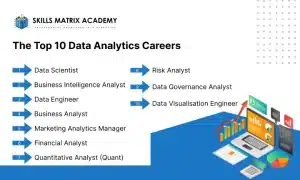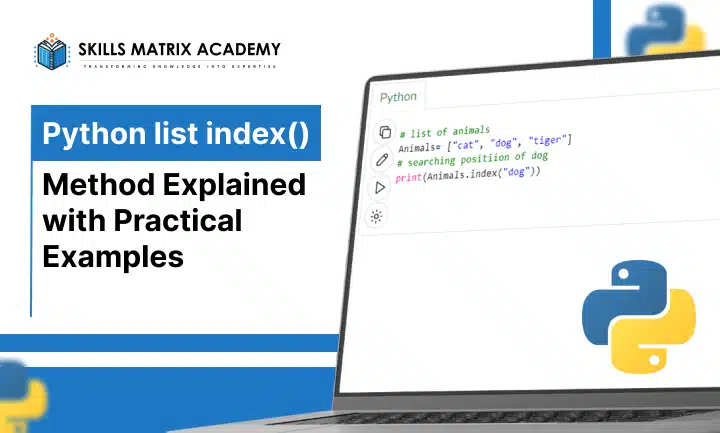Imagine landing your dream job—one where you work with numbers, decode patterns, and make impactful, data-driven decisions every day. That’s the power of being a data analyst—transforming raw information into meaningful insights that drive real results.
Data analytics isn’t just a career; it’s an evolving journey of solving complex problems, uncovering trends, and converting unstructured data into clear, actionable visuals. As industries like healthcare, finance, e-commerce, and technology rely heavily on data, demand for skilled data analysts is rising rapidly.
As we move into 2025, there’s never been a better time to step into this dynamic field and build a rewarding, future-ready career.
In this blog, we’ll explore the top 5 high-paying data analyst jobs in India, the best places to find these roles, and what skills make you the perfect fit for each position.
Why Choose a Career in Data Analytics?

A data analytics career is one of the most exciting and rewarding paths today. You’ve probably heard about its high earning potential and high-demand analytics careers — and both are true. But there’s more to it than just numbers and paychecks.
1. Variety of Roles
The analytics field offers a wide range of analytics job roles. You can become a data scientist, business analyst, or data engineer. Each role matches different interests and data analytics skills, allowing you to build a path that suits your strengths.
2. Use of Technology
If you’re passionate about innovation, technology in analytics will inspire you. Professionals use modern data analytics tools and technologies to extract meaningful insights from data. It’s a mix of challenge and creativity that keeps the work exciting.
3. Impactful Work
A career in analytics lets you make a tangible difference. Your analysis helps companies make data-driven decisions, boosting performance and growth. The impact of data analytics touches every industry today — from healthcare to finance.
4. Career Growth and Job Security
With endless career advancement in analytics, professionals can start from entry-level positions and quickly move up. The data analytics industry offers stability and strong job security, as organisations rely more on data.
The Top 10 Data Analytics Careers

Analytics touches almost every industry today. Companies use it to make smarter choices. If you like data, there are many career paths to choose from. Below are the top 10 data analytics careers. Each role shows what you do, the skills you need, pay signals, job outlook, and a course to get started. I kept sentences short and precise. Read fast. Decide smarter.
1. Data Scientist
A data scientist digs deep into data. They turn messy numbers into real insights. This role blends math, coding, and business sense.
Job responsibilities:
Collect, analyse, and interpret large, complex datasets.
Use statistical and machine-learning techniques to identify patterns.
Build predictive models and guide business decisions.
Required skills:
Background in computer science, statistics, or mathematics.
Proficiency in Python and R.
Strong modelling and experimental design skills.
Average salary:
The U.S. average was about $123,069 in 2024. Location and experience change the pay.
Career prospects:
Very strong. The BLS projects 36% growth from 2023 to 2033.
Course to start with:
Begin with a Data Scientist with Python or a Data Scientist with R track. Build projects and models.
2. Business Intelligence Analyst
A business intelligence (BI) analyst simplifies data for leaders. They create dashboards and reports that drive decisions.
Job responsibilities:
Collect and analyse business data.
Build visual dashboards for non-technical teams.
Translate findings into action plans.
Required skills:
Background in business or a related field.
Experience with Power BI, SQL, Excel, and Tableau.
Understanding of data warehousing.
Average salary:
Glassdoor reports an average salary of around $101,000 per year in the U.S. for 2024.
Career prospects:
Strong. The BLS projects 11% growth from 2023 to 2033.
Course to start with:
Try an Introduction to Power BI course to build sharp reporting skills.
3. Data Engineer
A data engineer builds and maintains the data systems. They make sure data is ready for analysis.
Job responsibilities:
Design and build infrastructure for data collection and storage.
Manage large data sets and databases.
Ensure data is accurate, accessible, and secure.
Required skills:
Strong programming in Python, Java, and SQL.
Experience with big data tools like Hadoop and Spark.
Knowledge of ETL and pipeline design.
Average salary:
Around $127,315 per year in the U.S. going into 2025.
Career prospects:
Very strong. Data engineers are in high demand as systems scale.
Course to start with:
The Data Engineer with Python career track teaches pipelines and system design.
4. Business Analyst
A business analyst focuses on business problems and solutions. They combine domain knowledge with analytics.
Job responsibilities:
Identify and analyse business problems and opportunities.
Develop solutions to improve processes and performance.
Communicate with stakeholders to gather requirements.
Required skills:
Strong analytical and problem-solving skills.
Excellent communication and presentation skills.
Familiarity with SQL, Excel, and Tableau.
Average salary:
The average BA salary is about $84,778 per year.
Career prospects:
Strong. BLS predicts about 25% growth by 2030.
Course to start with:
SQL for Business Analysts helps you build reports and make data-driven decisions.
5. Marketing Analytics Manager
A marketing analytics manager measures what works in marketing. They optimize campaigns and measure ROI.
Job responsibilities:
Collect and analyse data to inform marketing strategies.
Measure campaign performance and customer engagement.
Present insights and recommend optimisations.
Required skills:
Analytics and problem-solving skills.
Experience with marketing analytics tools and visualisation.
Knowledge of SQL, Excel, Python, and R.
Average salary:
Glassdoor shows about $112,000 per year in the U.S.
Career prospects:
Good. Comparable marketing research roles show growth near 8%.
Course to start with:
Try the Marketing Analytics with Python track to learn campaign analysis and churn prediction.
6. Financial Analyst
A financial analyst uses data to make money-smart choices. The role is quantitative and strategy-focused.
Job responsibilities:
Collect and analyse financial data to inform decisions.
Identify trends and build financial models.
Create forecasts and communicate results.
Neededskills:
Strong modelling and analytical skills.
Experience with financial analysis tools.
Knowledge of SQL, Excel, R, and Python.
Average salary:
Glassdoor reports an average salary of roughly $79,000 per year.
Career prospects:
Solid. The BLS projects 9% growth in financial and investment analyst positions (2021–2031).
Course to start with:
Finance Fundamentals in Python teaches modelling and data-driven finance skills.
7. Quantitative Analyst (Quant)
A quantitative analyst applies math to finance. Quants build models for trading and risk.
Job responsibilities:
Use math and statistics to model financial systems.
Spot patterns in market and economic data.
Build and implement quantitative investment strategies.
Required skills:
Strong math background (engineering, physics, or mathematics).
Programming in Python and R.
Deep statistical knowledge.
Average salary:
Glassdoor lists the average at around $147,000.
Career prospects:
Strong. Quant roles remain in high demand in finance.
Course to start with:
Quantitative Analyst with R covers modelling, trading, and risk strategies.
8. Risk Analyst
A risk analyst identifies and measures potential threats. They help organisations avoid costly mistakes.
Job responsibilities:
Identify, assess, and prioritise organisational risks.
Develop risk management strategies.
Communicate findings and mitigation plans.
Required skills:
Analytical and problem-solving skills.
Experience in risk assessment and analysis.
Knowledge of Python, R, and SQL.
Average salary:
Glassdoor reports an average salary of around $85,000 per year.
Career prospects:
Strong. Market reports show significant growth in demand for risk management.
Course to start with:
Quantitative Risk Management courses in Python or R are ideal entry points.
9. Data Governance Analyst
A data governance analyst protects data quality and compliance. They build rules and standards for data use.
Job responsibilities:
Develop and implement data governance policies.
Ensure data accuracy, accessibility, and security.
Coordinate standards across the organisation.
Required skills:
Experience with data governance and data management.
Analytical thinking and strong communication.
Knowledge of SQL, Python, and Java.
Average salary:
Glassdoor shows roughly $113,000 per year.
Career prospects:
Strong. The data governance market is expanding rapidly.
Course to start with:
Begin with the Data Governance Concepts course to learn the basics of policy and process.
10. Data Visualisation Engineer
A data visualisation engineer turns numbers into stories. They design dashboards and interactive visuals.
Job responsibilities:
Design and develop interactive visualisations and dashboards.
Use tools that make data clear for stakeholders.
Gather requirements and translate them into visual solutions.
Required skills:
Experience with Tableau, D3.js, and R Shiny.
Strong skills in Python, R, and Power BI.
Good visual design sense and communication.
Average salary:
Glassdoor lists about $106,000 per year in the U.S.
Career prospects:
Strong. Visual analytics is critical for data-driven teams.
Course to start with:
Courses in Python, Power BI, R, and Tableau prepare you for this role.
How to Choose the Right Analytics Job
Different roles match different strengths. Here’s a short guide:
Love math and modelling? Aim for a data scientist or quant.
Enjoy building systems? Data engineer fits.
Prefer business strategy? Try business analyst or BI analyst.
Like visuals and storytelling? Choose a data visualisation engineer.
Interested in finance? Look at financial or risk analyst roles.
Pick what interests you. Then build the right skills. Small steps lead to significant change
Top Analytics Career Skills

If you’re planning to start or grow your career in data analytics, mastering the right skills is essential. Today’s businesses rely on data to make wise decisions—and they need professionals who can turn raw numbers into insights.
Let’s explore the top analytics career skills you need to build a strong future in this field.
1. Learn Key Programming Languages
Every data analyst must know a few powerful programming languages. The most popular ones are Python, SQL, R, and Julia.
Python is the top choice for data analysis and machine learning professionals. With libraries like pandas, NumPy, and scikit-learn, you can clean, analyse, and model data efficiently. The Data Scientist with Python course is a great starting point.
SQL is essential for managing data stored in databases. Learn it through SQL Fundamentals, then move on to SQL for Business Analysts for advanced queries.
R is the perfect language for statistical modelling and data visualisation tasks. Libraries like ggplot2 and Shiny make it a favourite among researchers.
Julia is gaining attention for high-performance analytics and numerical computation. Begin with Julia Fundamentals to understand its power in modern analytics.
2. Master Data Visualisation
Data means little without visuals. That’s why data visualisation is one of the most essential skills in data analytics.
Learn tools like Tableau and Power BI to build interactive dashboards. These business intelligence tools help you clearly share insights.
If you prefer coding, Python offers great visualisation libraries—matplotlib, seaborn, and Plotly—to create detailed, customised charts.
Strong visuals make your analysis easier to understand and more persuasive.
3. Get Comfortable with Data Wrangling and Cleaning
In real-world analytics, most of your time is spent on data wrangling and cleaning. You’ll deal with missing values, merge datasets, and convert inconsistent data types.
Courses like Cleaning Data in Python or Cleaning Data in R can help you learn how to prepare clean, reliable datasets. Clean data means accurate insights—something every business values.
4. Strengthen Your Statistical Analysis and Machine Learning Skills
Understanding statistics is the foundation of every successful analyst. It helps you find patterns, test ideas, and make data-driven decisions.
Once you’re confident with statistical analysis, take the next step—machine learning. With tools like scikit-learn, you’ll learn model building, evaluation, and predictive analytics.
Machine learning gives you the power to forecast trends and build more innovative business strategies.
5. Build Communication and Storytelling Skills
Finally, great analysts don’t just crunch numbers—they tell stories with data. Combine your data visualisation tools with clear communication to make your insights impactful.
Whether you’re creating Power BI dashboards, Tableau dashboards, or presentations, focus on clarity and meaning.
Final Thoughts
Data analytics is one of the most exciting and fast-growing fields today. With the right skills and mindset, you can explore countless analytics career opportunities.
Whether it’s data science, business intelligence, or emerging areas like AI ethics and MLOps, the demand for analytics professionals continues to rise. These analytics jobs offer competitive salaries, strong career growth, and future-proof opportunities.
By learning programming, mastering data visualisation, and improving your statistical analysis, you can build a strong foundation for success. Keep upskilling with expert-led data analytics training to stay ahead in this ever-evolving field.
If you’re ready to start your career in data analytics, enrol with an IT training institute in Jaipur like ours and begin your journey with the Data Analyst in Python course today.








